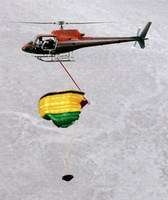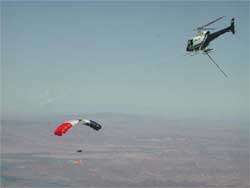Sun Is Closer Than We Thought

This September, NASA is set to bring back a tiny sampling of the raw material of the Sun, a sample weighing no more than a few grains of salt.
In a dramatic ending that marks a beginning in scientific research, NASA's Genesis spacecraft is set to swing by Earth and jettison a sample return capsule filled with particles of the Sun that may ultimately tell us more about the genesis of our solar system.
"The Genesis mission -- to capture a piece of the Sun and return it to Earth -- is truly in the NASA spirit: a bold, inspiring mission that makes a fundamental contribution to scientific knowledge," said Steven Brody, NASA's program executive for the Genesis mission, NASA Headquarters, Washington.
_______________________________________________________
More about Genesis:
The solar particles are sealed inside the Genesis sample return capsule, a disk about the size of a truck tire, that will drift toward Earth's surface beneath a parachute.
In labs specially designed to measure small numbers of atoms, scientists will begin years of close examination of the particles in search of new information about how the Sun and its family of planets came into being.
The sample is composed of the invisible ions (atoms stripped of many of their electrons) that flow off the Sun -- making up what's called the "solar wind." The solar wind streams constantly throughout our solar system. Like water flowing around a stone in a river, the solar wind moves along the outside of the magnetic fields of Earth and other planets. Sometimes, we can see an effect produced by the solar wind in the form of an aurora near the Earth's poles. The glowing curtains of light are the colorful result of these particles spiraling into Earth's atmosphere along the magnetic field lines that dip inward at the poles.
______________________________________________________
On September 8, 2004, the drama will unfold over the skies of central Utah when the spacecraft's sample return capsule will be snagged in midair by helicopter. The rendezvous will occur at the Air Force's Utah Test and Training Range, southwest of Salt Lake City.
"What a prize Genesis will be," said Genesis Principal Investigator Dr. Don Burnett of the California Institute of Technology, Pasadena, Calif. "Our spacecraft has logged almost 27 months far beyond the moon's orbit, collecting atoms from the Sun. With it, we should be able to say what the Sun is composed of, at a level of precision for planetary science purposes that has never been seen before."

The prizes Burnett and company are waiting for are hexagonal wafers of pure silicon, gold, sapphire, diamond and other materials that have served as a celestial prison for their samples of solar wind particles. These wafers have weathered 26-plus months in deep space and are now safely stowed in the return capsule. If the capsule were to descend all the way to the ground, some might fracture or break away from their mountings; hence, the midair retrieval by helicopter, with crew members including some who have performed helicopter stunt work for Hollywood.
"These guys fly in some of Hollywood's biggest movies," said Don Sweetnam, Genesis project manager at NASA's Jet Propulsion Laboratory in Pasadena, Calif. "But this time, the Genesis capsule will be the star."
The Genesis capsule -- carrying the agency's first sample return since the final Apollo lunar mission in 1972, and the first material collected beyond the Moon -- will enter Earth's atmosphere at 9:55 am Mountain Time. Two minutes and seven seconds after atmospheric entry, while still flying supersonically, the capsule will deploy a drogue parachute at 33 kilometers (108,000 feet) altitude. Six minutes after that, the main parachute, a parafoil, will deploy 6.1 kilometers (20,000 feet) up. Waiting below will be two helicopters and their flight crews looking for their chance to grab a piece of the Sun.
"Each helicopter will carry a crew of three," said Roy Haggard, chief executive officer of Vertigo Inc. and director of flight operations for the lead helicopter. "The lead helicopter will deploy an eighteen-and-a-half foot long pole with what you could best describe as an oversized, Space-Age fishing hook on its end. When we make the approach we want the helicopter skids to be about eight feet above the top of the parafoil. If for some reason the capture is not successful, the second helicopter is 1,000 feet behind us and setting up for its approach. We estimate we will have five opportunities to achieve capture."
The helicopter that does achieve capture will carry the sample canister to a clean room at the Michael Army Air Field at the U.S. Army Dugway Proving Ground, where scientists await their cosmic prize. The samples will then be moved to a special laboratory at NASA's Johnson Space Center, Houston, where they will be preserved and studied by scientists for many years to come.
"I understand much of the interest is in how we retrieve Genesis," added Burnett. "But to me the excitement really begins when scientists from around the world get hold of those samples for their research. That will be something."
JPL, a division of the California Institute of Technology, manages the Genesis mission for NASA's Science Mission Directorate, Washington. Lockheed Martin Space Systems, Denver, developed and operates the spacecraft. Los Alamos National Laboratory and NASA's Johnson Space Center contributed to Genesis payload development, and the Johnson Space Center will curate the sample and support analysis and sample allocation.
More About Genesis Mission:
Genesis is the agency's first sample return mission since the last Apollo mission in 1972, and the first ever to return material collected beyond the Moon. The science collection began November 30, 2001, with the opening of the spacecraft's science canister and the extension of special collector arrays to catch atoms from the solar wind. The atoms it has collected, believed to have preserved the composition of the solar nebula "cloud" from which our solar system developed, will help scientists better understand conditions in the distant past before Earth and other planets formed.
Little did the Beatles know their metaphor would be taken literally one day. To the team behind NASA's Genesis mission, it has been years since they sent their "little darling," a small spacecraft with a wingspan of 22 feet (6.8 meters), out to collect and bring back a piece of the Sun.
"After more than two years of collecting solar wind ions, we're thrilled that the Genesis spacecraft is about to close up and come home," said Donald Sweetnam, Genesis project manager at NASA's Jet Propulsion Laboratory, Pasadena, Calif. "On Thursday, April 1, we turn off the solar wind concentrator, stow the collector arrays, close the science canister cover, and lock it tight. The day after that, we will close the sample return capsule backshell and latch it in the configuration necessary for entry through Earth's atmosphere five months later on September 8."
Scientists have long wanted to capture a sample of particles straight from the Sun. While the Sun is mostly made up of hydrogen and helium, there are small amounts of all other elements as well. The exact composition of the Sun is yet to be determined, as is an understanding of how that chemical makeup resulted in the diverse collection of planets and other bodies in the solar system.
For the Genesis scientists, it is crucial that the particles be pure and unaltered from any interaction with Earth's magnetic field. To obtain this pristine sample, a spacecraft had to be sent deep into space, far beyond the extensive magnetic environment of Earth.
NASA's Genesis, a robotic spacecraft, was launched in August 2001 from Cape Canaveral, Florida. It traveled to an area in space between Earth and the Sun where the gravity of the two bodies is balanced. There, it collected solar wind particles for more than two years from an area in space far from the interfering effects of any planet.
The particles were embedded in specially designed and manufactured, high-purity wafers of sapphire, silicon, diamond and other materials. Now this pure sample of solar particles is being brought to Earth.
Source: NASA
















